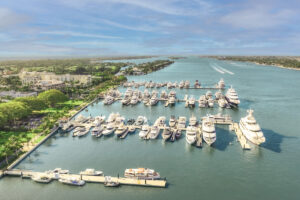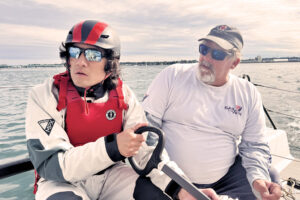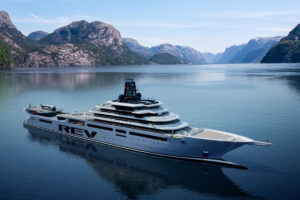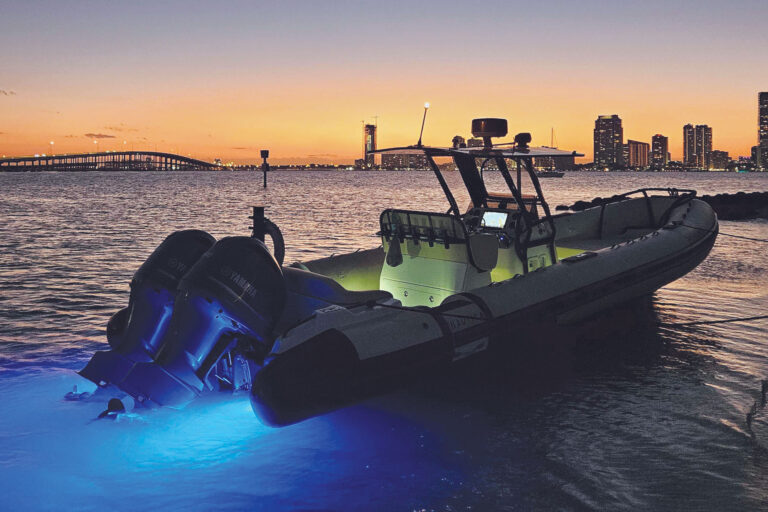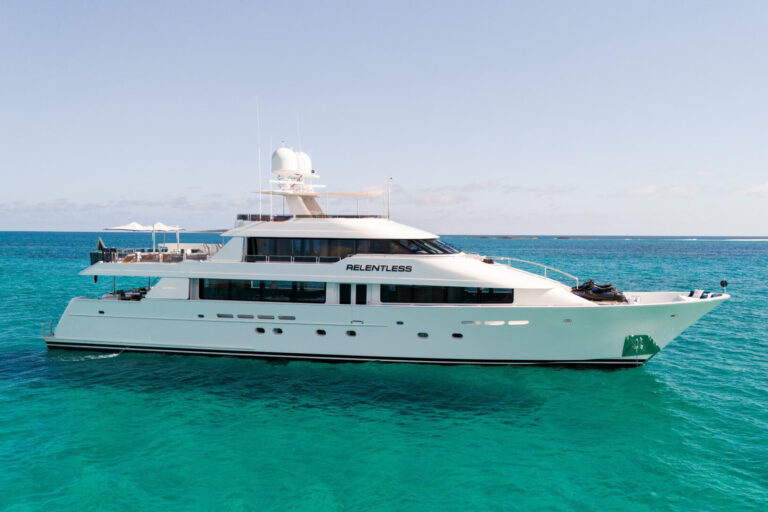Six years before Charles Darwin set sail on the HMS Beagle in one of modern history’s most famous voyages of discovery, Capt. Benjamin Morrell witnessed an eruption of Fernandina, the westernmost volcano in the Galápagos Islands. From the helm of the seal-hunting schooner Tartar, Morrell saw a tower of raging hellfire: 2,000-degree molten rock spewing from the island’s belly into 30-foot-wide rivers of destruction that punched through each other, suffocated everything in their path and collided with the Pacific Ocean in a boiling, screeching hiss.
Morrell’s flagging sails caught a life-saving breeze about the time the air temperature reached 147 degrees. Tar was melting from the rigging. Pitch was oozing from the vessel’s seams. When he finally reached a safe place to anchor more than 50 miles away, he could still hear Fernandina’s thunderous rumbling. He was undoubtedly stunned to have escaped with his life.
Today, Fernandina’s bright sun and warm breeze are decidedly more hospitable to those who visit by boat. The island’s silent crater looms high overhead, but the furious lava’s remains have cooled into sometimes sharp, sometimes ropy patterns of black rock. They are now some of the most awe-inspiring walking trails in the world.
The Galápagos Islands have been a destination of enchantment for yachtsmen since 1535, when the Bishop of Panama sailed off course on his way to Peru, landed more than 600 miles west of Ecuador and recorded descriptions of tortoises weighing 500 pounds, each with a shell larger than a saddle, or galápago. Today, those giant tortoises and other creatures from Darwin’s writings draw 50,000 to 60,000 visitors each year.
Boating is tightly restricted to protect what pristine areas remain in the islands, which Ecuador declared a national park in 1959, but a select few charter yachts offer a comfortable platform from which to explore. One is the 125-foot motoryacht Parranda, which served as our home base for eight days last fall courtesy of her parent company, Miami-based Quasar Nautica.
From Parranda‘s dinghy, known locally as a panga, we set foot on some of the chain’s outermost islands, each with a visage more coated than the next by animal droppings thicker than powdered sugar on an overgrown coffee cake. There are no docks, no roads and no civilization at most landings, only trails that offer one fascinating experience after another.
“It isn’t a spot for a guy with a deal pending who needs to get in touch with his office,” said Jennifer Reynolds, Quasar Nautica’s marketing director. “It’s a spot for the guy who needs to get away and doesn’t want his office to be able to find him.
Most people who visit the Galápagos write about the giant tortoises, which there would be more of had whalers not stacked tens of thousands of their ancestors upside-down in ship’s holds as a food source that could live for a year with no food or water. Looking such an amazing creature in the eye with that knowledge tugs at your heartstrings, and it is crushing when you learn the original tortoises floated across the Pacific from southern Chile, more than 1,000 miles away.
Still, the 350-pound creatures show little fear, as do most of the animals that live on the islands where man’s goats and dogs have yet to overrun the natural balance. Blue-footed boobies tend to their hatchlings while nesting in the middle of walking trails, oblivious to tourists high-stepping over their beaks. A 250-pound sea lion waddles into the path of a dozen humans, moving only when they clap to shoo it away. Thousands of slithering, 3-foot-long marine iguanas force visitors to maneuver like slalom skiers in their wake along the rocky shoreline.
Every once in a while, a lava chunk shifts under a charter guest’s space-age hiking shoe-a subtle geological reminder that we are just another species, a few frail creatures nature has graciously allowed to explore her most humbling of hideaways.
The standard of yachting luxury in the Galápagos is different from that in the Caribbean or Mediterranean. Rules designed to protect the environment have intentionally slowed the development of tourism and kept competition minimal. You will not find a charter yacht with satellite television and a fax machine. Cell phone service is spotty at best, even in Puerto Ayora, a full-functioning harbor with cafés and small shops where establishing an Internet connection can take nearly a half-hour.
“This place really hasn’t been touched by the 21st century,” Reynolds said.
Luxury means air conditioning, edible fresh fruit, hot showers and unlimited bottled water. It means a crew that will keep your belongings safe while you’re in the dinghy surrounded by 40-foot whales, then offer you a cocktail with a smile when you tell them about it in a language they may not fully understand.
This is the level of service that makes Parranda an excellent charter choice. The Galápagos Islands are about the ability to experience things most humans never will, and to discover things about your own humanity you never would dream otherwise. Parranda is one of the few yachts that offer a safe, comfortable base for such an extraordinary adventure.
Getting to Parranda requires flying into Ecuador’s capital, Quito, and staying overnight before a morning flight to the Galápagos airport in Baltra. Quito is no picnic, but Quasar’s land-based sister company, Amerindia, ensured we were safe. Upon landing in Baltra, we met our guide, Boly Sanchez, who is an example of the kind of staff that sets Parranda apart.
Sanchez is a Naturalist III, the highest level of guide available in the Galápagos and the only level of guide used aboard Parranda, Reynolds said. His certification means he is fluent in English, has a university education and has some training in biology; lower-level guides speak only Spanish and basically keep tourists from straying off the trails. Our experience with Sanchez was excellent, from his nightly briefings about what to expect at our next destination to his handling of a medical emergency one guest experienced 48 hours from the nearest hospital.
Particularly entertaining were the explanations Sanchez provided during each excursion. Some of the islands are little more than a sea of animals whose coos and whistles and honks and belches seem more distinct than those elsewhere on the planet, like stars that glow in skies uncluttered by city lights. Sanchez helps you understand what you’re seeing and hearing, to the point that it becomes difficult to push Darwinian thinking out of your mind.
For example, I now find laughable the idea that humans are somehow superior in the intimate rituals of sexuality. Witness the male frigate birds, which, to garner the attention of females overhead, inflate a red balloon-like pouch under their black necks. The biggest colorful display wins the girl, just like a tall stack of $25,000 royal blue chips at Ceasar’s in Vegas. Also witness the female boobies, which need to be wooed by dancing. Males arch their bodies and flap their wings in a goofy display not unlike a desperate teen’s rhythm at a high school prom.
As I congratulated myself on the scientific contemplation of this erotic ornithology, a booby dropped a bomb from about 30 feet above that nailed me square on the head.
I was simultaneously a member of the only species capable of higher mathematics and of no greater value than an encrusted lava rock.
It was another indication that our own power is small, particularly compared with the raw muscle under the sea. On Isabela Island, which has five volcanoes to Fernandina’s one, fishermen arrived in 1954 to find living shellfish a mile inland. Scientists say the earth simply pushed upward 40 feet to create a new shoreline in a few hours. Brain coral is still along the inland trails, as are sunburned sea urchins.
In 1825, when Capt. Morrell finally anchored safely beyond the hell spewing from Fernandina’s core, he said he “felt grateful to heaven for having the rest of his life before him.
Leaving the inspiring wonder of the Galápagos after a week of charter today will make most people feel the same way.
Contact: Fraser Yachts Worldwide, (954) 463-0600; fax (954) 462-1028; charter@fraserfl.com; www.fraseryachts.com; Quasar Nautica, (800) 247-2925; fax (305) 592-7060; www.quasarnautica.com; or any charter broker. Parranda charters at $44,000 per week, including food, fuel and guide, for 16 guests.

